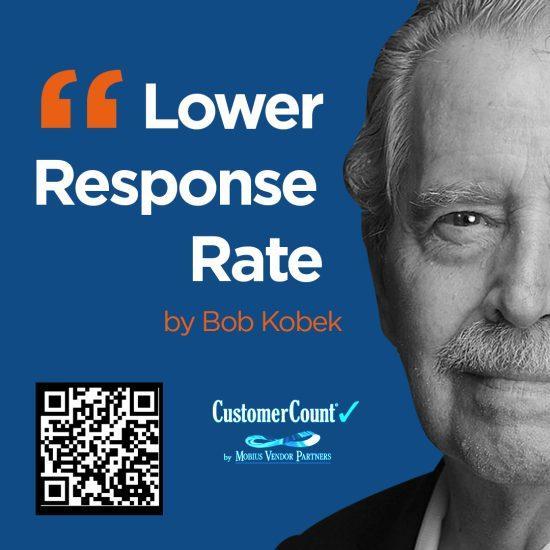SURVEY MYTHS DEBUNKED
ISSUE # 1: LOW RESPONSE RATES

By Bob Kobek, President of Mobius Vendor Partners
First and most importantly – shameless self-promotion: If you are concerned about low survey response rates – look to a professional in the space. There are always variables that might cause that, and there are certainly solutions. But a blanket statement that “survey response rates are declining” is a misnomer, at best, and is often a self-serving comment made by alternative feedback programs.
There is one very important question that needs to be asked: what is the purpose of the survey? To capture the voice of
the customer, gain information for process improvement, measure experiences (customer, patient, employee, etc.? Each one of these will carry very different variables.
In political campaigns there is a bloc of voters who do not vote. That seems a bit incongruous, but it is a number, expressed in a percentage, of people who ‘vote with their feet’ and they are calculated into election day projections.
That bloc can be higher or lower than estimated but not by much. Patterns don’t make abrupt turns and when they do, they are anomalies. And there are an unlimited number of variables that can cause those variances.
In some ways, election day is much like a survey (not to be confused with a poll) where the voter preference turns into the ultimate Net Promoter Score – NPS. They would be referred to as ‘passives.
In fact – there is no empirical data that I am aware of that proves response rates are declining across the board for survey response. They may decline for one hospital but increase for a hotel. Decline for an auto dealer and increase for a bank. I am also not aware of any data that demonstrates a decline in ‘industry wide’ surveys.
Certainly, there are industries/businesses that create ‘survey fatigue’ on their own through increased incidences of invitations but that is a creation of an amateur survey deployment. And, in health care, fatigue can be very real if a patient is being treated by an organization that bills Medicare as a form of payment. Those surveys are mandated to protect the cost of health care. I can argue the way they are deployed is the most expensive method of delivery, but that is another topic for another blog.
First, determine if there is a solution in search of a problem or a problem in search of a solution, and look for as many variables as possible. Examples:
Affinity
A high response rate is driven by high levels of motivation to complete the survey, or a strong personal relationship between business and customer. Survey response rates in the 5% to 30% range are far more typical.
What is the business relationship between you and your customers? Is it purely transactional? That can contribute to lower response rates.
Delivery vehicle
Are you deploying the survey online, over phone, or via snail mail?
The CMS survey has expanded its delivery vehicles to include ‘web’ to increase response rate. This along with phone and mail will certainly increase the Medicare mandated survey.
Invitation information
What information are you collecting? Address, email, phone number? Is your invitation verbiage really inviting?
Delivery rates
There is a difference between delivery and response.
B2B or B2C
B2B will be lower by nature of security protocols at the corporate level.
There are many, many reasons for the perception of low response rates, but there is another factor to consider as well. The difference between response rates and completion rates.
Some people believe the terms response rate and completion rate are synonymous. But, in online survey research, these two terms have different meanings. Where response rate is meant to identify the percentage of your sample who respond to your survey, completion rate determines the percentage of respondents who completed your survey.
So, are ‘response rates’ declining? It depends and, if so, there are reasons that can explain it when you take a closer look. If your organization is looking to meaningfully capture customer, patient and employee feedback, you need a professional to help you consider these factors and craft surveys that work.
For additional credible information visit the Education Scientist @ Acceptable Survey Response Rate Calculator – EducationScientists
Next Up: Survey Fatigue



